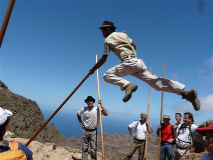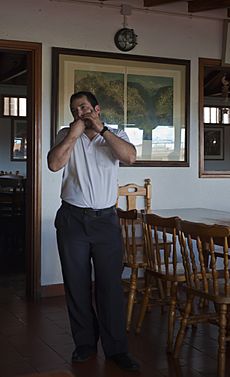Canary Islanders facts for kids
| Total population | |
|---|---|
| c. 1,600,000 | |
| Regions with significant populations | |
72.1% of the total Canary Islands population |
|
| Significant Canary Islander diaspora in | |
| Total unknown | |
| 42,671 | |
| 40,602 | |
| 2,390 | |
| 1,600 | |
| Languages | |
| Canarian Spanish, Silbo Gomero | |
| Religion | |
| Predominantly Roman Catholic (85%) |
|
| Related ethnic groups | |
| Isleños, other Spaniards, Madeirans, Portuguese, Berbers (Guanches) | |
Canary Islanders, or Canarians (Spanish: canarios), are the people of the Canary Islands, an autonomous community of Spain near the coast of northwest Africa. The distinctive variety of the Spanish language spoken in the region is known as habla canaria (Canary speech) or the (dialecto) canario (Canarian dialect). The Canarians, and their descendants, played a major role during the conquest, colonization, and eventual independence movements of various countries in Latin America. Their ethnic and cultural presence is most palpable in the countries of Uruguay, Venezuela, Cuba and the Dominican Republic as well as the U.S. territory of Puerto Rico.
Contents
History
The original inhabitants of the Canary Islands are commonly known as Guanches (although this term in its strict sense only refers to the original inhabitants of Tenerife). They are most probably descendants of the Berber peoples of northern Africa.
The islands were conquered by Castile at the beginning of the 15th century. In 1402, they began to subdue and suppress the native Guanche population. The Guanches were initially enslaved and gradually absorbed. As a result, genetic analyses of modern Canarians show mainly a mixture of European and North African genes, and low frequencies of sub-Saharan genes, with quite a lot of variation (see Ancestry).
After subsequent settlement by Europeans, the remaining Guanches were gradually assimilated by the settlers and their culture largely vanished. Alonso Fernández de Lugo, conqueror of Tenerife and La Palma, oversaw extensive immigration to these islands during a short period from the late 1490s to the 1520s from mainland Europe, mostly Castile and Portugal. At subsequent judicial enquiries, Fernández de Lugo was accused of favoring Genoese and Portuguese immigrants over Castilians.
Culture
Modern-day Canarian culture is Spanish, with some Guanche influences. Some of the Canarian traditional sports such as lucha canaria ("Canarian fight"), juego del palo ("stick game") or salto del pastor ("shepherd's jump"), among others, have their roots in Guanche culture. Additionally, other traditions include Canarian pottery, words of Guanche origin in the Canarian speech and the rural consumption of guarapo gomero and gofio. The inhabitants of La Gomera also retain an ancient way of communicating across deep ravines by means of a whistled speech called Silbo Gomero, which can be heard up to 3 km (2 miles) away. This indigenous whistled language was invented by the Guanches, and was then adopted by the Spanish settlers in the 16th century after the Guanches were culturally assimilated into the population. The language was also formerly spoken on El Hierro, Tenerife and Gran Canaria
The holidays celebrated in the Canary Islands are of international, national and regional or insular character. The official day of the autonomous community is Canary Islands Day on 30 May. The anniversary of the first session of the Parliament of the Canary Islands, based in the city of Santa Cruz de Tenerife, held on 30 May 1983, is commemorated with this day. The most famous festival of the Canary Islands is the carnival. The carnival is celebrated in all the islands and all its municipalities, perhaps the two busiest being those of the two Canarian capitals; the Carnival of Santa Cruz de Tenerife (Tourist Festival of International Interest) and the Carnival of Las Palmas de Gran Canaria. It is celebrated on the streets between the months of February and March. But the rest of the islands of the archipelago have their carnivals with their own traditions among which stand out: The Festival of the Carneros of El Hierro, the Festival of the Diabletes of Teguise in Lanzarote, Los Indianos de La Palma, the Carnival of San Sebastián de La Gomera and the Carnival of Puerto del Rosario in Fuerteventura.
The strong influence of Latin America in Canarian culture is due to the constant emigration and return over the centuries of Canarians to that continent, chiefly to Puerto Rico, Cuba, the Dominican Republic, and Venezuela. To a lesser extent, they also went to the US states of Louisiana (mostly the southern portion) and Texas (mostly in and around San Antonio), and some areas in eastern Mexico including Nuevo León and Veracruz.
Religion
Catholic Church
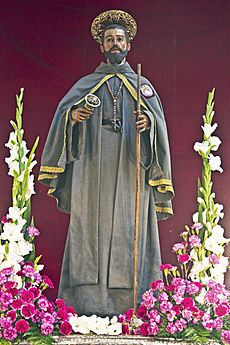
The majority of native Canary Islanders are Roman Catholic with various smaller foreign-born populations of other Christian beliefs such as Protestants from northern Europe.
The appearance of the Virgin of Candelaria (Patron of Canary Islands) was credited with moving the Canary Islands toward Christianity. Two Catholic saints were born in the Canary Islands: Peter of Saint Joseph de Betancur and José de Anchieta. Both born on the island of Tenerife, they were respectively missionaries in Guatemala and Brazil.
The Canary Islands are divided into two Catholic dioceses, each governed by a bishop:
- Diócesis Canariense: Includes the islands of the Eastern Province: Gran Canaria, Fuerteventura and Lanzarote. Its capital was San Marcial El Rubicón (1404) and Las Palmas de Gran Canaria (1483–present). There was a previous bishopric which was based in Telde, but it was later abolished.
- Diócesis Nivariense: Includes the islands of the western province: Tenerife, La Palma, La Gomera and El Hierro. Its capital is San Cristóbal de La Laguna (1819–present).
Other religions
Around 5 percent of Canarians belong to a minority religion. Separate from the overwhelming Christian majority are a minority of Muslims who are usually foreign-born. At present, there are in the Canary Islands a figure of approximately 70,000 Muslims and 40 mosques and places of worship throughout the archipelago.
Among the followers of Islam, the Islamic Federation of the Canary Islands exists to represent the Islamic community in the Canary Islands as well as to provide practical support to members of the Islamic community.
Statistics
The distribution of beliefs in 2012 according to the CIS Barometer Autonomy was as follows:
- Catholic 84.9%
- Atheist/Agnostic/Unbeliever 12.3%
- Other religions 1.7%
Among the believers 38.7% go to religious services frequently.
Canarian diaspora
Historically, the Canary Islands have served as a hub between Spain and the Americas; favoured by that circumstance, large groups of Canary islanders have emigrated and settled all over the New World as early as the 15th century, mainly in Cuba, Puerto Rico, Dominican Republic, Colombia, Venezuela and Uruguay.
Demographics
The Canarian population includes long-tenured and new waves of mainland Spanish immigrants, including Andalucians, Galicians, Castilians, Catalans, Basques and Asturians of Spain; old settlers of Portuguese, Italian, the Dutch or Flemish, British, and French origin, as well as recent foreign-born arrivals. In 2019 the total population was 2,153,389, of which 72.1% were native Canary Islanders. A total of 80.6%, or 1,735,457, were born in Spain and 19.4%, or 417,932, were born outside the country. Of these, the majority are from the Americas, mainly from Venezuela (66,573) and Cuba (41,792) and Colombia (31,368). There are 38,768 people from Africa, the majority from Morocco (24,268).
| Population history | ||
|---|---|---|
| Year | Population | |
| 1768 | 155,763 | |
| 1787 | 168,928 | |
| 1797 | 173,865 | |
| 1842 | 241,266 | |
| 1860 | 237,036 | |
| 1887 | 301,983 | |
| 1900 | 364,408 | |
| 1920 | 488,483 | |
| 1940 | 687,937 | |
| 1960 | 966,177 | |
| 1981 | 1,367,646 | |
| 1990 | 1,589,403 | |
| 2000 | 1,716,276 | |
| 2010 | 2,118,519 | |
| 2011 | 2,082,655 | |
| 2019 | 2,152,590 | |
| Population of the Canary Islands 2019 | |||
|---|---|---|---|
| Birthplace | Population | Percent | |
| 1,553,517 | 72.1 | ||
| Other regions (Spain) | 176,302 | 8.2 | |
| Total, Spain | 1,735,457 | 80.6 | |
| Foreign-born | 417,932 | 19.4 | |
| Americas | 201,257 | 9.3 | |
| Venezuela | 66,573 | - | |
| Cuba | 41,792 | - | |
| Colombia | 31,361 | - | |
| Argentina | 17.429 | - | |
| Uruguay | 8,687 | - | |
| Rest of Europe | 154,511 | 7.2 | |
| Italy | 39,469 | - | |
| Germany | 25,921 | - | |
| United Kingdom | 25,339 | - | |
| Africa | 38,768 | 1.8 | |
| Morocco | 24,268 | - | |
| Asia | 23,082 | 1.1 | |
| China | 9,848 | - | |
| Oceania | 314 | 0.0 | |
| Total | 2,153,389 | 100.0% | |
| Source | |||
Canarian identity
According to a 2012 study by the Centro de Investigaciones Sociológicas, when asked about national identity, the majority of respondents from the Canary Islands (49.3%) consider themselves Spanish and Canarian in equal measures, followed by 37.1% who consider themselves more Canarian than Spanish. Only 6.1% of the respondents consider themselves only Canarian.
| National Sentiment in the Canary Islands | |||
|---|---|---|---|
| Only Spanish | 3.5% | ||
| More Spanish than Canarian | 2.0% | ||
| Equally Spanish and Canarian | 49.3% | ||
| More Canarian than Spanish | 37.1% | ||
| Only Canarian | 6.1% | ||
| Did not answer | 2.0% | ||
Notable Canarians
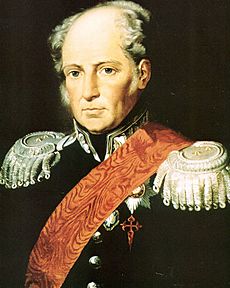
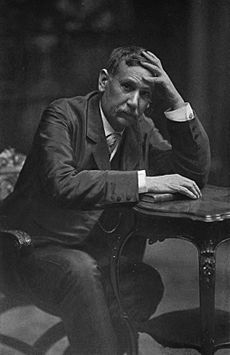
- Wenceslao Benítez Inglott, navy officer, scientist, and engineer.
- Javier Bardem, actor
- José de Anchieta, Jesuit priest, saint and missionary in Brazil.
- Rosana Arbelo, singer
- Mary of Jesus de León y Delgado, Dominican lay Sister and mystic.
- Amaro Pargo, one of the most famous corsairs of the golden age of piracy.
- Rafael Arozarena, writer
- Carolina Bang, actress
- Bencomo, pre-Hispanic King
- Beneharo, pre-Hispanic King
- Agustín de Betancourt y Molina, engineer, Russian General
- Peter of Saint Joseph Betancur, saint and missionary in Guatemala.
- Manolo Blahnik, fashion designer
- José Comas Quesada, painter
- Óscar Domínguez, painter
- Ana Guerra, singer
- Agoney, singer
- Doramas, pre-Hispanic warrior
- José Doreste, sailor, yacht racer and Olympic champion
- Luis Doreste, sailor, yacht racer and world champion and Olympic champion
- Ruslan Ela, soccer player
- Nicolás Estévanez, politician
- Juan Carlos Fresnadillo, filmmaker
- Pedro García Cabrera, poet
- Antonio González y González, scientist, chemist
- Fernando Guanarteme, pre-Hispanic king
- Pedro Guerra, music composer and singer
- Ángel Guimerá, writer
- Emeterio Gutiérrez Albelo, poet
- Nancy Fabiola Herrera, mezzo-soprano opera singer
- K-Narias, reggaeton pop duo
- Alfredo Kraus, opera singer
- Fernando León y Castillo, politician
- Juan Fernando López Aguilar, politician and jurist, former Minister of Justice
- Domingo López Torres, painter, writer, poet and Marxist revolutionary
- Maninidra, pre-Hispanic warrior
- César Manrique, artist
- Cristo Marrero Henríquez, professional footballer
- Manolo Millares, painter
- Francisco de Miranda, Venezuelan general, politician and precursor of South America independence
- Manuel Mora Morales, writer and filmmaker
- Juan Negrín, politician
- Leopoldo O'Donnell, General and statesman
- Frances Ondiviela, telenovela actress, former Miss Spain and model
- María Orán, soprano
- Benito Pérez Galdós, writer
- Domingo Pérez Minik, writer
- Narciso Rodriguez, American fashion designer born to Cuban parents with Canarian origins
- Sergio Rodríguez, NBA basketball player
- Pedro, professional footballer
- Aythami Ruano, judoka
- Jerónimo Saavedra, politician, mayor of Las Palmas and two times president of Canaries
- Victoria Sanchez, actress in American and Canadian movies and TV series
- David Silva, football player
- Carla Suárez Navarro, tennis player
- Tanausu, pre-Hispanic King of Aceró
- Tinguaro, pre-Hispanic warrior General
- Goya Toledo, actress and model
- Juan Carlos Valerón, football player
- Alberto Vázquez-Figueroa, writer
- José Vélez, singer
- Juan Verde Suárez, politician
- José Viera y Clavijo, historian
- Eduardo Westerdahl, painter, art critic and writer, member of the Surrealist movement
See also
 In Spanish: Pueblo canario para niños
In Spanish: Pueblo canario para niños
- Berberism
- Canarian dialect
- Cubans
- Guanche language
- Isleños
- Nationalities in Spain
- White Puerto Ricans
- White Dominicans (Dominican Republic)


